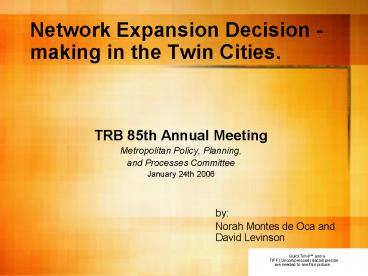Network Expansion Decision making in the Twin Cities. - PowerPoint PPT Presentation
1 / 16
Title:
Network Expansion Decision making in the Twin Cities.
Description:
Network Expansion Decision - making in the Twin Cities. TRB 85th Annual Meeting ... rules used by jurisdictions in the Minnesota's Twin Cities metropolitan area. ... – PowerPoint PPT presentation
Number of Views:68
Avg rating:3.0/5.0
Title: Network Expansion Decision making in the Twin Cities.
1
Network Expansion Decision - making in the Twin
Cities.
- TRB 85th Annual Meeting
- Metropolitan Policy, Planning,
- and Processes Committee
- January 24th 2006
by Norah Montes de Oca and David Levinson
2
Introduction and Background
- Research aims to build empirically based network
- growth prediction models.
Why?
- Will business as usual network construction
- decision rules produce desirable networks?
- Will new decision rules produce improved
networks? - Should policies be changed to direct future
network - growth in a better direction? Or to produce
networks - that will generate the best performance
measures?
3
Entire project overview
- Decision Rules.
- Code Decision Rules
- Code Set of proposed Decision Rules
- Run model for various forecast years under
different scenarios. - Assess Results using performance measures
- Results would let decision makers see how
previous investment decision rules impact or
limit future choices.
4
Objective
- Present a qualitative analysis of the
decision-rules used by jurisdictions in the
Minnesotas Twin Cities metropolitan area.
Metro Area v.s. State Area 3.5
Population 56 All road miles 11 All
road lane miles 12
5
Methodology
- Face to face interviews
- Using open-ended questions
- Who was interviewed?
- Minnesota Department of Transportation-
- Program Management Department
- Metropolitan Council-Planning Management
- Department
- Metro Area Managers
- County Engineers and staff
- City - Capital and Management Department
6
Questionnaire
- Procedure for a project to be approved for
construction? - Most important policies to look at when making
decisions? - Main choosing criteria?
- Performance measures considered?
- Ranking system existence?
- Changes in criteria from the past to actual?
- Informal procedures?
- Role of politicians in the decision-making
process?
7
Processes
Findings
- Structured process
- Ranking system
- through point allocation
- Task forces-committees
- Formal
- Priorities
- safety,preservation, capacity,
- social and economic impacts,
- community and agency involvement
- Benefit/cost ratio, etc.
- No Ranking System
- Informal
8
Informal Processes
- Jurisdictions priorities and decision making
- Benefit/cost ratio gt 1
- AADT lt 15,000 on 3-lane roadways (safety
reasons) - Intersection volumes up to 7,500 vehicles per
day - Implementation of policy, strategy and
investment level - Project development time
- Most beneficial project for the system
- Matching funds from local jurisdictions
9
Formal Processes
10
Flowcharts-Informal processes
Roadways under Countys jurisdiction
Scott County
Project solicitation
Application review
Safety
Average Daily Traffic (ADT)
yes
ADTgt15,000 3 lane-roads
Project in top 200 high crash location list
no
yes
yes
Reapplication?
no
Project approval
no
no
End
yes
Project construction
11
Flowcharts - Formal Processes - City
Minneapolis streets
Project solicitation
Application review
Compute scores
Highest scored project selection
yes
Allocation of funding availability
Reapplication?
Project approval
no
End
no
yes
City of Minneapolis
Project construction
12
Flowcharts - Formal Processes - Metropolitan
Council
13
Analysis and Evaluation
- Priorities between every level of government
vary - Main general criteria
- 1)Safety
- 2)Pavement conditions/maintenance
- 3)Capacity-ADT
- Benefit/Cost Analysis - not a common criteria
- Jurisdictions believe the factors cannot be
categorized - monetarily
- - Trade off between safety and capacity
projects - Jurisdictions expressed concern for
air/environmental - quality as a factor.
14
General Conclusions
- Perception gap on decision making process.
- References to official documents about safety,
capacity, pavement conditions, and so on, but not
a clear answer. - In the past, projects selected on the engineers
perception. However, safety issues, road
conditions and capacity were present in the
engineers minds. - Levels of government with no ranking system -
main criterion based on performance measures. - Safety-most important.
- Counties containing Metropolitan Area center have
a more formal decision-making process and a
ranking system.
15
Conclusions-continued
- Mn/DOT has backed away from a formal process as
described in the 1997 Transportation System Plan.
Now more informal, less quantitative process
Decrement in transparency. - At State level the biggest concern is what every
day transportation system user notices level of
congestion and a comfortable ride. - Jurisdictions declined to endorse flowcharts
presented, not providing alternatives. - Main reason.political community concern
16
Questions?
Comments?
Thank you































